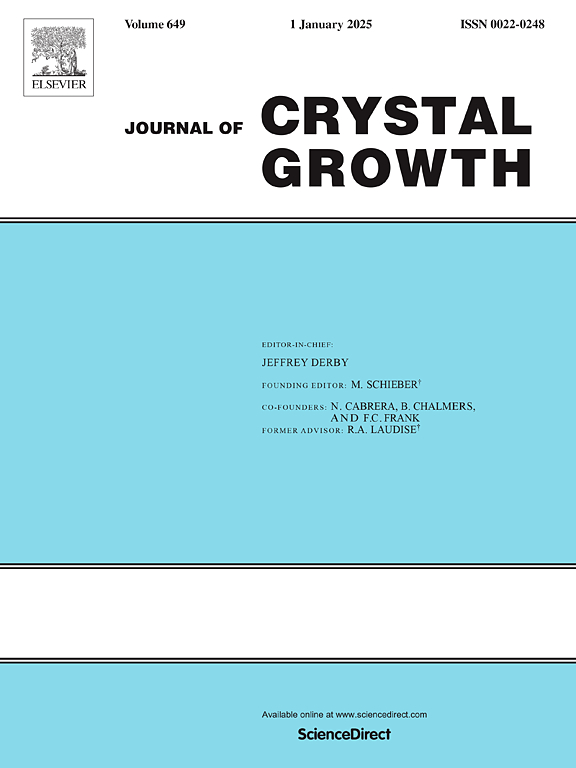Crystallinity and defect reduction in Cs2AgBiBr6: Key factors for enhanced optoelectronic devices
IF 2
4区 材料科学
Q3 CRYSTALLOGRAPHY
引用次数: 0
Abstract
Cs2AgBiBr6 double perovskites have attracted considerable interest for optoelectronic applications owing to their favorable structural stability and nontoxic composition. In this study, we systematically investigate the influence of two crystal growth methods—Single Crystal Growth (SCG) and Seed-Assisted Growth (SAG)—on the morphology, crystallinity, defect landscape, and optoelectronic properties of Cs2AgBiBr6 single crystals. Comprehensive characterization using scanning electron microscopy (SEM), X-ray diffraction (XRD), photoluminescence (PL), time-resolved photoluminescence (TRPL), impedance spectroscopy, and current–voltage (I–V) measurements reveals that the SAG method yields significantly larger and more uniform grains, improved structural coherence, and reduced defect densities compared to the SCG route. The narrower XRD peaks and reduced lattice strain in SAG-grown crystals confirm their higher crystallinity, while TRPL analysis shows extended carrier lifetimes, indicating suppressed nonradiative recombination due to fewer trap states. These structural and optical improvements directly enhance device performance, as SAG-grown crystals exhibit a 2.5-fold increase in photocurrent and a markedly lower dark current in photodetector configurations. Our findings establish the SAG technique as a superior and scalable approach for producing high-quality Cs2AgBiBr6 crystals, positioning them as promising candidates for next-generation optoelectronic devices, including photodetectors and light-emitting components.
Cs2AgBiBr6的结晶度和缺陷减少:增强光电器件的关键因素
Cs2AgBiBr6双钙钛矿由于其良好的结构稳定性和无毒成分而引起了人们对光电应用的极大兴趣。在本研究中,我们系统地研究了单晶生长(SCG)和种子辅助生长(SAG)两种晶体生长方法对Cs2AgBiBr6单晶形貌、结晶度、缺陷形貌和光电性能的影响。通过扫描电子显微镜(SEM)、x射线衍射(XRD)、光致发光(PL)、时间分辨光致发光(TRPL)、阻抗谱和电流-电压(I-V)测量的综合表征表明,与SCG方法相比,SAG方法可以产生更大、更均匀的晶粒,提高结构相干性,降低缺陷密度。在sagg生长的晶体中,更窄的XRD峰和更小的晶格应变证实了它们更高的结晶度,而TRPL分析显示载流子寿命延长,表明由于较少的陷阱态而抑制了非辐射重组。这些结构和光学方面的改进直接提高了器件的性能,因为sagg生长的晶体在光电探测器配置中表现出2.5倍的光电流增加和显著降低的暗电流。我们的研究结果表明,SAG技术是生产高质量Cs2AgBiBr6晶体的一种优越且可扩展的方法,将其定位为下一代光电器件(包括光电探测器和发光元件)的有前途的候选者。
本文章由计算机程序翻译,如有差异,请以英文原文为准。
求助全文
约1分钟内获得全文
求助全文
来源期刊

Journal of Crystal Growth
化学-晶体学
CiteScore
3.60
自引率
11.10%
发文量
373
审稿时长
65 days
期刊介绍:
The journal offers a common reference and publication source for workers engaged in research on the experimental and theoretical aspects of crystal growth and its applications, e.g. in devices. Experimental and theoretical contributions are published in the following fields: theory of nucleation and growth, molecular kinetics and transport phenomena, crystallization in viscous media such as polymers and glasses; crystal growth of metals, minerals, semiconductors, superconductors, magnetics, inorganic, organic and biological substances in bulk or as thin films; molecular beam epitaxy, chemical vapor deposition, growth of III-V and II-VI and other semiconductors; characterization of single crystals by physical and chemical methods; apparatus, instrumentation and techniques for crystal growth, and purification methods; multilayer heterostructures and their characterisation with an emphasis on crystal growth and epitaxial aspects of electronic materials. A special feature of the journal is the periodic inclusion of proceedings of symposia and conferences on relevant aspects of crystal growth.
 求助内容:
求助内容: 应助结果提醒方式:
应助结果提醒方式:


